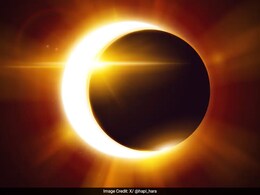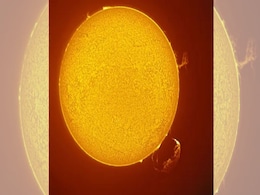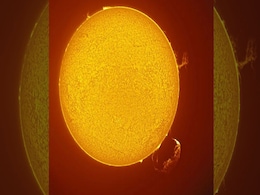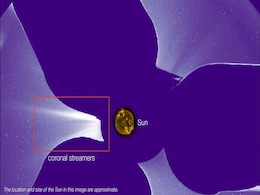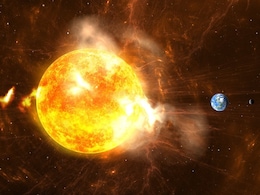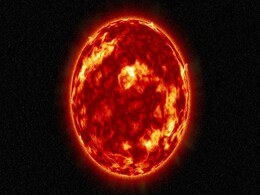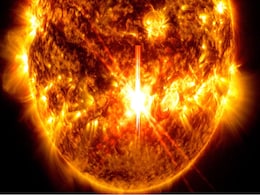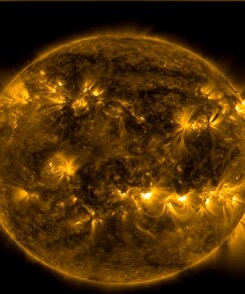Solar Maximum
- All
- News
- Videos
- Web Stories
-

2026 Could Be the Best Year for Northern Lights; Why Post-Solar Maximum Storms Are Set to Surge
- Sunday January 4, 2026
- Written by Gadgets 360 Staff
The end of 2025 saw bright auroras over northern skies following a strong solar flare. In October 2024, NASA noted that the Sun had entered its solar maximum phase. Experts predicted that the most frequent and intense Northern Lights would likely occur throughout 2026. Even though solar activity has technically begun its gradual decline since the 2...
-
 www.gadgets360.com
www.gadgets360.com
-

Solar Eclipse Of 2025: 10 Facts Students Should Know About It
- Sunday September 21, 2025
- Education | Edited by Lavkesh Singh
The last solar eclipse of 2025 takes place today, September 21. Students can learn 10 key facts about the eclipse, its timing, and when India will see its next solar eclipse.
-
 www.ndtv.com/education
www.ndtv.com/education
-

Researcher Photographs Giant Solar Tornado and Massive Plasma Eruption at the Same Time
- Monday August 25, 2025
- Written by Gadgets 360 Staff
On August 20, researcher Maximilian Teodorescu captured a rare photo of two dramatic solar events — a giant tornado of plasma rising 130,000 km and an eruptive prominence spanning 200,000 km. Both were shaped by the sun’s unstable magnetic fields. While the prominence did release a CME, it is not aimed at Earth.
-
 www.gadgets360.com
www.gadgets360.com
-

Rare Giant Solar Tornado and Plasma Eruption Captured Together on the Sun
- Sunday August 24, 2025
- Written by Gadgets 360 Staff
A Romanian researcher captured a rare sight on the Sun — a giant solar tornado alongside a massive plasma eruption. Both events, driven by magnetic field changes, highlight the Sun’s extreme activity during solar maximum. Luckily, the eruption’s CME is not headed toward Earth.
-
 www.gadgets360.com
www.gadgets360.com
-

What Is Solar Maximum And How Will It Affect Earth in 2025?
- Wednesday July 9, 2025
- Science | Edited by Srishti Singh Sisodia
Experts have advised people to monitor reliable sources like NASA and NOAA for updates on solar activity and space weather.
-
 www.ndtv.com
www.ndtv.com
-

NASA CODEX Telescope on ISS Reveals Hidden Secrets of the Sun’s Corona
- Wednesday July 2, 2025
- Written by Gadgets 360 Staff
NASA has introduced CODEX, a cutting-edge mini solar telescope attached to the International Space Station, which is offering groundbreaking observations of the Sun's corona. Unlike past instruments, CODEX can measure both temperature and speed of solar wind particles. This innovation aims to improve our understanding of solar weather, especially a...
-
 www.gadgets360.com
www.gadgets360.com
-

Solar Storms Are Causing Elon Musk's Starlink Satellites To Fall From The Sky
- Sunday June 8, 2025
- Science | Edited by Ritu Singh
The study revealed that geomagnetic storms caused by the Sun's eruptions increased atmospheric drag, causing satellites to re-enter faster than expected.
-
 www.ndtv.com
www.ndtv.com
-

Solar Eruptions Are Killing Off SpaceX's Starlink Satellites, NASA Study Reveals
- Wednesday May 28, 2025
- Science | Edited by Ritu Singh
The study found that solar storms cause satellites to re-enter the Earth's atmosphere faster than expected, reducing their lifespan by up to 10 days.
-
 www.ndtv.com
www.ndtv.com
-

Partial Solar Eclipse of March 2025: Satellite Images to Show Moon’s Shadow
- Saturday March 29, 2025
- Written by Gadgets 360 Staff
A partial solar eclipse will take place on March 29, 2025, visible across parts of Europe, Africa, and North America. The event will reach its peak in Nunavik, Canada, where 94% of the sun will be covered at sunrise. From space, weather satellites like GOES-16 and Himawari will capture images of the moon’s shadow. The International Space Station ...
-
 www.gadgets360.com
www.gadgets360.com
-

ESA Uses Solar Orbiter to Turn Solar Flares into Sound, Offering New Insights
- Thursday January 16, 2025
- Written by Gadgets 360 Staff
The European Space Agency (ESA), in collaboration with NASA, has used data from the Solar Orbiter mission to convert solar flares into audible sound. By mapping solar flare data into blue circles and pairing them with tones, a new way to experience solar activity has been created. This process is linked to the sun’s 11-year solar cycle, with curr...
-
 www.gadgets360.com
www.gadgets360.com
-

Solar Cycle 25: How the Sun’s Peak Activity Will Impact Earth in 2025
- Saturday December 28, 2024
- Written by Gadgets 360 Staff
Solar Cycle 25 continues with high activity levels in 2025. Increased solar flares and geomagnetic storms are anticipated, with risks to satellite systems and power grids. Widespread auroras could also light up low-latitude skies. Partial solar eclipses are scheduled for March and September in select regions. Observations indicate strong solar phen...
-
 www.gadgets360.com
www.gadgets360.com
-

Top 10 Solar Flares of 2024: The Most Powerful Solar Events and Their Impact
- Wednesday December 25, 2024
- Written by Gadgets 360 Staff
The Sun experienced significant solar activity in 2024, with over 50 X-class solar flares recorded. These powerful flares, originating from active regions like AR 13664, were accompanied by coronal mass ejections (CMEs) that caused geomagnetic storms and spectacular auroras across the globe. Among the strongest flares was the X9.0 recorded on Octob...
-
 www.gadgets360.com
www.gadgets360.com
-

Solar 'Battle Zone' Could be Even Worse Than Solar Maximum, Experts Warn
- Friday December 6, 2024
- Written by Gadgets 360 Staff
Experts warn that the sun's next phase, the "battle zone," could result in increased geomagnetic activity, lasting until 2028. This period could bring heightened solar flares and coronal holes, which may cause disruptions to satellites in low-Earth orbit. Space weather experts, including Scott McIntosh from Lynker Space, have noted that this phase ...
-
 www.gadgets360.com
www.gadgets360.com
-

Solar Activity Increase Results in Shortens Lifespan of Binar CubeSats
- Tuesday November 26, 2024
- Written by Gadgets 360 Staff
Curtin University’s Binar CubeSats, launched with a six-month mission lifespan, re-entered Earth's atmosphere after only two months due to unexpectedly high solar activity. This surge in solar phenomena has increased atmospheric drag, impacting the stability of satellites in low Earth orbit. As solar forecasting remains limited, smaller satellite...
-
 www.gadgets360.com
www.gadgets360.com
-

NASA’s 15-Year-Old NEOWISE Spacecraft Re-Enters Earth's Atmosphere After 15 Years in Space
- Wednesday November 6, 2024
- Written by Gadgets 360 Staff
NASA's NEOWISE spacecraft, originally launched as WISE in 2009, has ended its mission after nearly 15 years in operation. It successfully identified around 3,000 near-Earth objects and contributed significant data to the scientific community. NEOWISE's demise was attributed to the current solar maximum, leading to its atmospheric re-entry. As NEOWI...
-
 www.gadgets360.com
www.gadgets360.com
-

2026 Could Be the Best Year for Northern Lights; Why Post-Solar Maximum Storms Are Set to Surge
- Sunday January 4, 2026
- Written by Gadgets 360 Staff
The end of 2025 saw bright auroras over northern skies following a strong solar flare. In October 2024, NASA noted that the Sun had entered its solar maximum phase. Experts predicted that the most frequent and intense Northern Lights would likely occur throughout 2026. Even though solar activity has technically begun its gradual decline since the 2...
-
 www.gadgets360.com
www.gadgets360.com
-

Solar Eclipse Of 2025: 10 Facts Students Should Know About It
- Sunday September 21, 2025
- Education | Edited by Lavkesh Singh
The last solar eclipse of 2025 takes place today, September 21. Students can learn 10 key facts about the eclipse, its timing, and when India will see its next solar eclipse.
-
 www.ndtv.com/education
www.ndtv.com/education
-

Researcher Photographs Giant Solar Tornado and Massive Plasma Eruption at the Same Time
- Monday August 25, 2025
- Written by Gadgets 360 Staff
On August 20, researcher Maximilian Teodorescu captured a rare photo of two dramatic solar events — a giant tornado of plasma rising 130,000 km and an eruptive prominence spanning 200,000 km. Both were shaped by the sun’s unstable magnetic fields. While the prominence did release a CME, it is not aimed at Earth.
-
 www.gadgets360.com
www.gadgets360.com
-

Rare Giant Solar Tornado and Plasma Eruption Captured Together on the Sun
- Sunday August 24, 2025
- Written by Gadgets 360 Staff
A Romanian researcher captured a rare sight on the Sun — a giant solar tornado alongside a massive plasma eruption. Both events, driven by magnetic field changes, highlight the Sun’s extreme activity during solar maximum. Luckily, the eruption’s CME is not headed toward Earth.
-
 www.gadgets360.com
www.gadgets360.com
-

What Is Solar Maximum And How Will It Affect Earth in 2025?
- Wednesday July 9, 2025
- Science | Edited by Srishti Singh Sisodia
Experts have advised people to monitor reliable sources like NASA and NOAA for updates on solar activity and space weather.
-
 www.ndtv.com
www.ndtv.com
-

NASA CODEX Telescope on ISS Reveals Hidden Secrets of the Sun’s Corona
- Wednesday July 2, 2025
- Written by Gadgets 360 Staff
NASA has introduced CODEX, a cutting-edge mini solar telescope attached to the International Space Station, which is offering groundbreaking observations of the Sun's corona. Unlike past instruments, CODEX can measure both temperature and speed of solar wind particles. This innovation aims to improve our understanding of solar weather, especially a...
-
 www.gadgets360.com
www.gadgets360.com
-

Solar Storms Are Causing Elon Musk's Starlink Satellites To Fall From The Sky
- Sunday June 8, 2025
- Science | Edited by Ritu Singh
The study revealed that geomagnetic storms caused by the Sun's eruptions increased atmospheric drag, causing satellites to re-enter faster than expected.
-
 www.ndtv.com
www.ndtv.com
-

Solar Eruptions Are Killing Off SpaceX's Starlink Satellites, NASA Study Reveals
- Wednesday May 28, 2025
- Science | Edited by Ritu Singh
The study found that solar storms cause satellites to re-enter the Earth's atmosphere faster than expected, reducing their lifespan by up to 10 days.
-
 www.ndtv.com
www.ndtv.com
-

Partial Solar Eclipse of March 2025: Satellite Images to Show Moon’s Shadow
- Saturday March 29, 2025
- Written by Gadgets 360 Staff
A partial solar eclipse will take place on March 29, 2025, visible across parts of Europe, Africa, and North America. The event will reach its peak in Nunavik, Canada, where 94% of the sun will be covered at sunrise. From space, weather satellites like GOES-16 and Himawari will capture images of the moon’s shadow. The International Space Station ...
-
 www.gadgets360.com
www.gadgets360.com
-

ESA Uses Solar Orbiter to Turn Solar Flares into Sound, Offering New Insights
- Thursday January 16, 2025
- Written by Gadgets 360 Staff
The European Space Agency (ESA), in collaboration with NASA, has used data from the Solar Orbiter mission to convert solar flares into audible sound. By mapping solar flare data into blue circles and pairing them with tones, a new way to experience solar activity has been created. This process is linked to the sun’s 11-year solar cycle, with curr...
-
 www.gadgets360.com
www.gadgets360.com
-

Solar Cycle 25: How the Sun’s Peak Activity Will Impact Earth in 2025
- Saturday December 28, 2024
- Written by Gadgets 360 Staff
Solar Cycle 25 continues with high activity levels in 2025. Increased solar flares and geomagnetic storms are anticipated, with risks to satellite systems and power grids. Widespread auroras could also light up low-latitude skies. Partial solar eclipses are scheduled for March and September in select regions. Observations indicate strong solar phen...
-
 www.gadgets360.com
www.gadgets360.com
-

Top 10 Solar Flares of 2024: The Most Powerful Solar Events and Their Impact
- Wednesday December 25, 2024
- Written by Gadgets 360 Staff
The Sun experienced significant solar activity in 2024, with over 50 X-class solar flares recorded. These powerful flares, originating from active regions like AR 13664, were accompanied by coronal mass ejections (CMEs) that caused geomagnetic storms and spectacular auroras across the globe. Among the strongest flares was the X9.0 recorded on Octob...
-
 www.gadgets360.com
www.gadgets360.com
-

Solar 'Battle Zone' Could be Even Worse Than Solar Maximum, Experts Warn
- Friday December 6, 2024
- Written by Gadgets 360 Staff
Experts warn that the sun's next phase, the "battle zone," could result in increased geomagnetic activity, lasting until 2028. This period could bring heightened solar flares and coronal holes, which may cause disruptions to satellites in low-Earth orbit. Space weather experts, including Scott McIntosh from Lynker Space, have noted that this phase ...
-
 www.gadgets360.com
www.gadgets360.com
-

Solar Activity Increase Results in Shortens Lifespan of Binar CubeSats
- Tuesday November 26, 2024
- Written by Gadgets 360 Staff
Curtin University’s Binar CubeSats, launched with a six-month mission lifespan, re-entered Earth's atmosphere after only two months due to unexpectedly high solar activity. This surge in solar phenomena has increased atmospheric drag, impacting the stability of satellites in low Earth orbit. As solar forecasting remains limited, smaller satellite...
-
 www.gadgets360.com
www.gadgets360.com
-

NASA’s 15-Year-Old NEOWISE Spacecraft Re-Enters Earth's Atmosphere After 15 Years in Space
- Wednesday November 6, 2024
- Written by Gadgets 360 Staff
NASA's NEOWISE spacecraft, originally launched as WISE in 2009, has ended its mission after nearly 15 years in operation. It successfully identified around 3,000 near-Earth objects and contributed significant data to the scientific community. NEOWISE's demise was attributed to the current solar maximum, leading to its atmospheric re-entry. As NEOWI...
-
 www.gadgets360.com
www.gadgets360.com


